Management Accounting Principle
VerifiedAdded on 2023/05/29
|9
|1518
|415
AI Summary
This article discusses the principles, benefits, types and methods of management accounting. It also covers the integration of management account and the difference between absorption costing and marginal costing. An example of variable cost and its income statement is also provided.
Contribute Materials
Your contribution can guide someone’s learning journey. Share your
documents today.
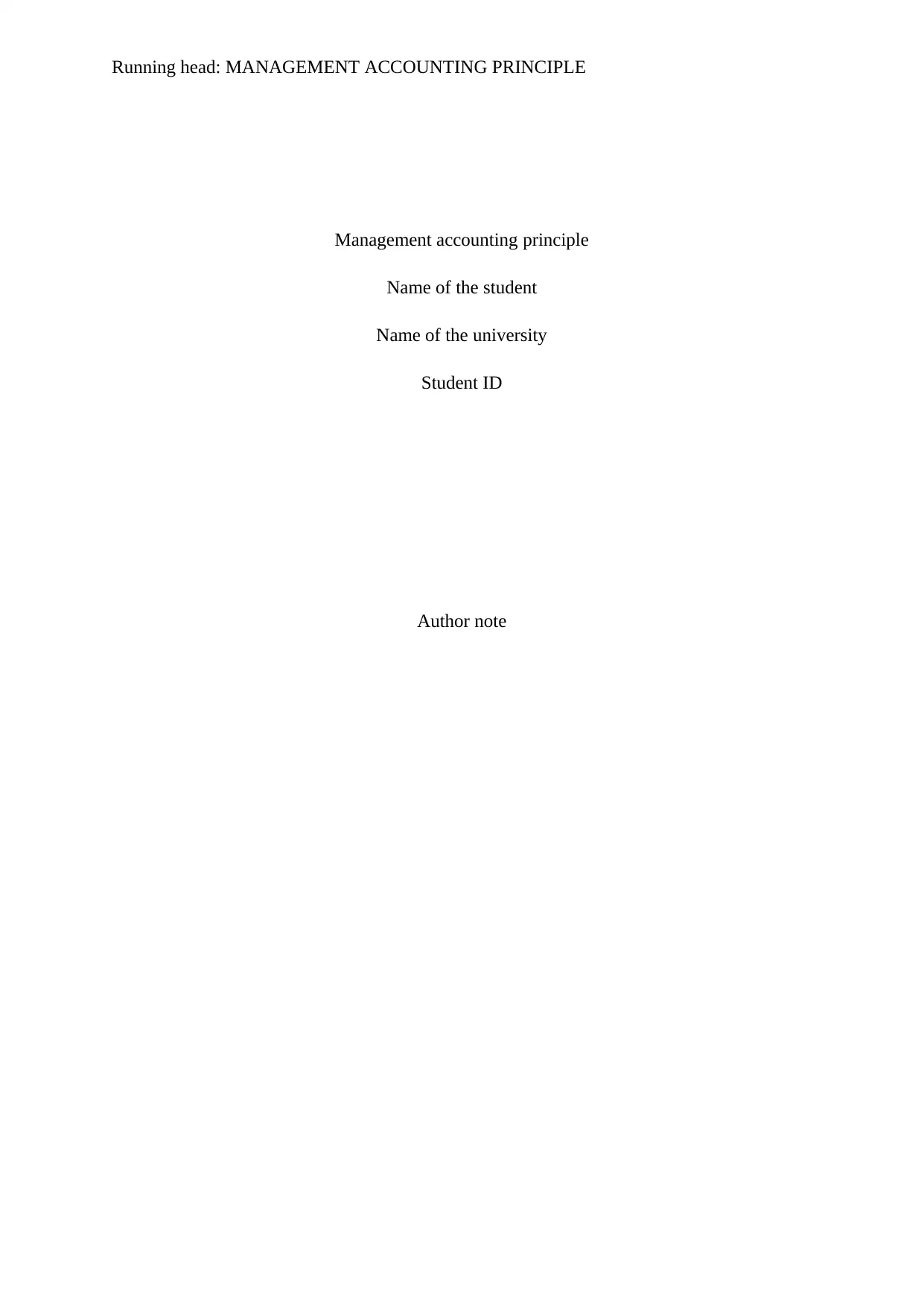
Running head: MANAGEMENT ACCOUNTING PRINCIPLE
Management accounting principle
Name of the student
Name of the university
Student ID
Author note
Management accounting principle
Name of the student
Name of the university
Student ID
Author note
Secure Best Marks with AI Grader
Need help grading? Try our AI Grader for instant feedback on your assignments.
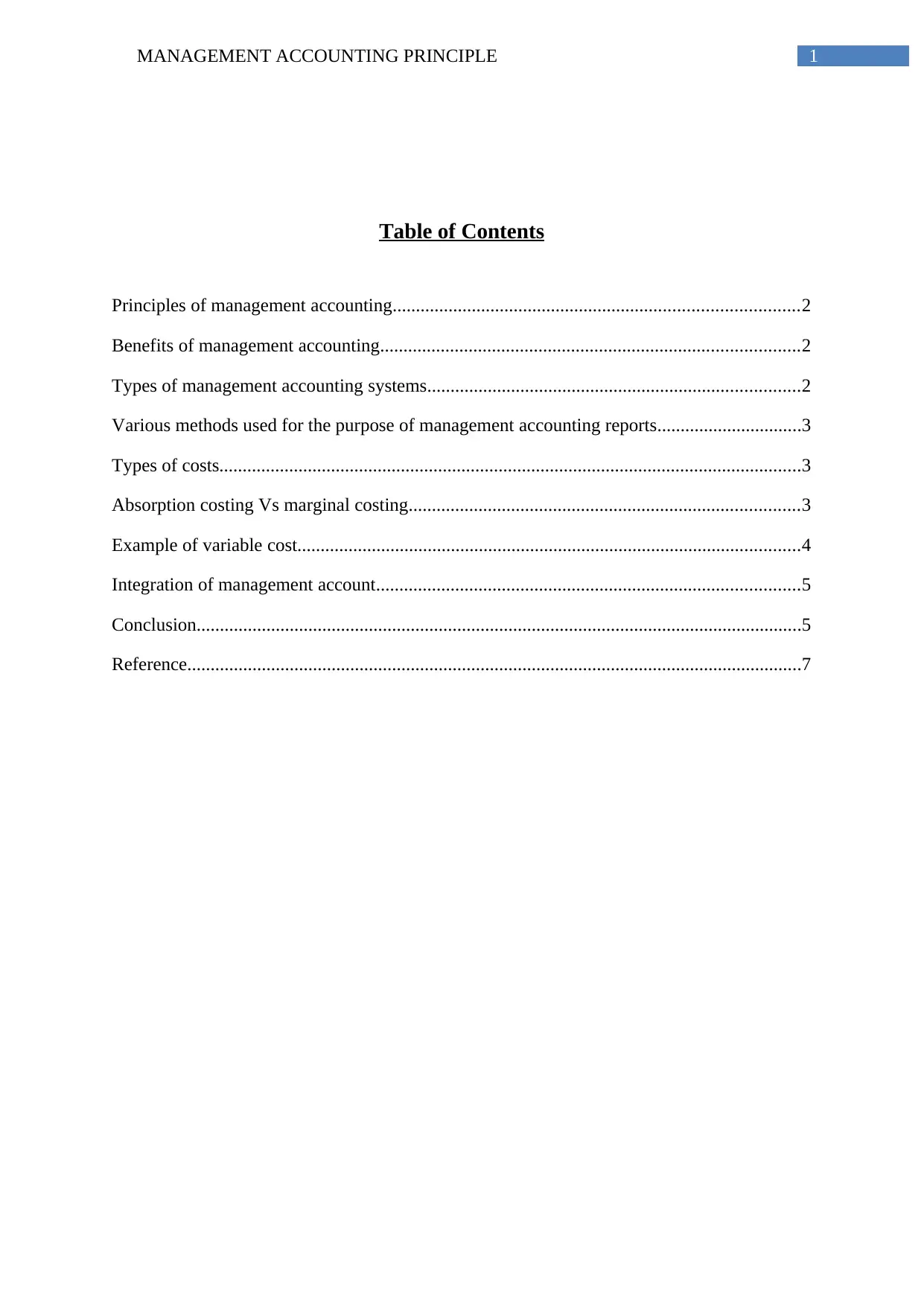
1MANAGEMENT ACCOUNTING PRINCIPLE
Table of Contents
Principles of management accounting.......................................................................................2
Benefits of management accounting..........................................................................................2
Types of management accounting systems................................................................................2
Various methods used for the purpose of management accounting reports...............................3
Types of costs.............................................................................................................................3
Absorption costing Vs marginal costing....................................................................................3
Example of variable cost............................................................................................................4
Integration of management account...........................................................................................5
Conclusion..................................................................................................................................5
Reference....................................................................................................................................7
Table of Contents
Principles of management accounting.......................................................................................2
Benefits of management accounting..........................................................................................2
Types of management accounting systems................................................................................2
Various methods used for the purpose of management accounting reports...............................3
Types of costs.............................................................................................................................3
Absorption costing Vs marginal costing....................................................................................3
Example of variable cost............................................................................................................4
Integration of management account...........................................................................................5
Conclusion..................................................................................................................................5
Reference....................................................................................................................................7
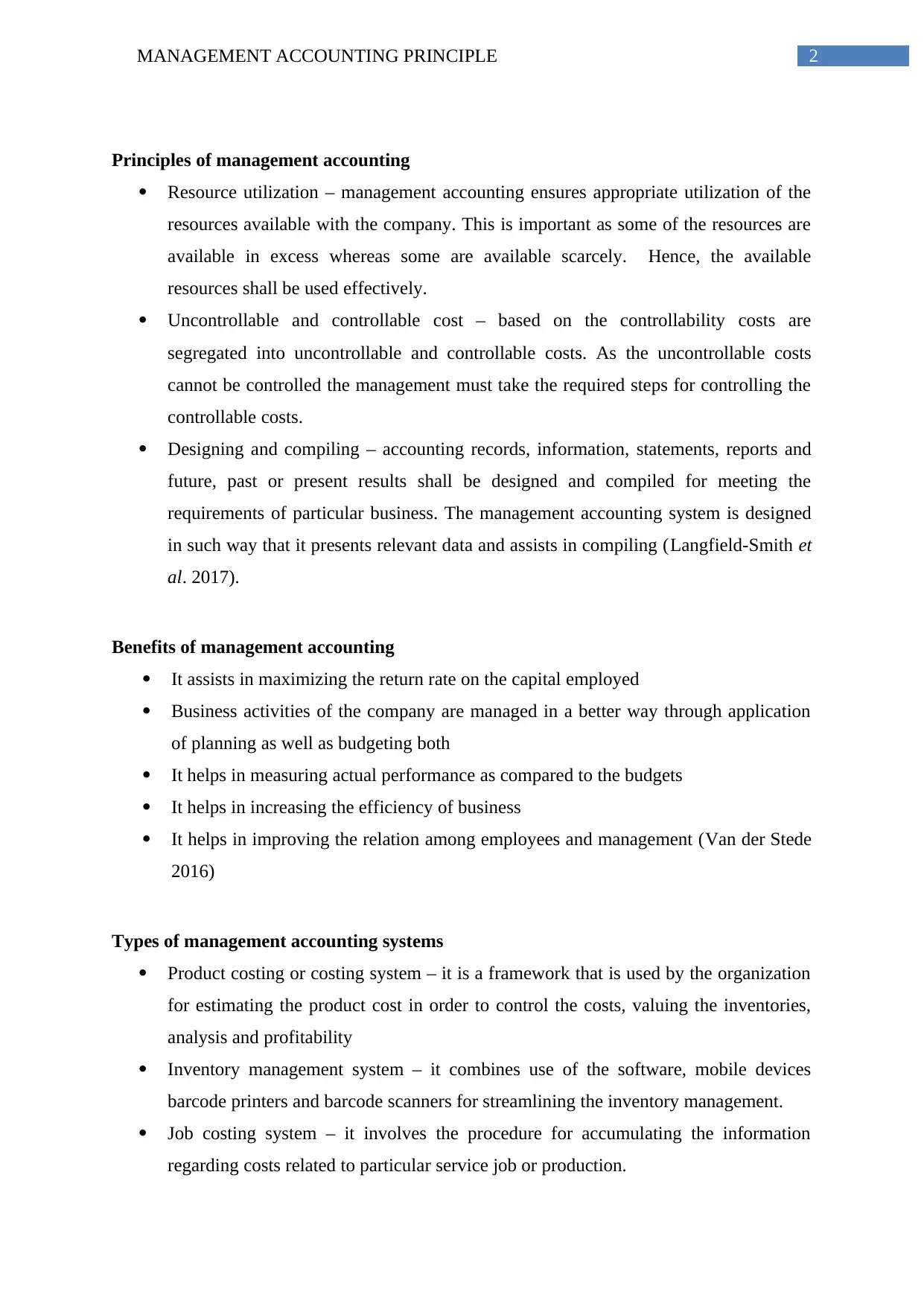
2MANAGEMENT ACCOUNTING PRINCIPLE
Principles of management accounting
Resource utilization – management accounting ensures appropriate utilization of the
resources available with the company. This is important as some of the resources are
available in excess whereas some are available scarcely. Hence, the available
resources shall be used effectively.
Uncontrollable and controllable cost – based on the controllability costs are
segregated into uncontrollable and controllable costs. As the uncontrollable costs
cannot be controlled the management must take the required steps for controlling the
controllable costs.
Designing and compiling – accounting records, information, statements, reports and
future, past or present results shall be designed and compiled for meeting the
requirements of particular business. The management accounting system is designed
in such way that it presents relevant data and assists in compiling (Langfield-Smith et
al. 2017).
Benefits of management accounting
It assists in maximizing the return rate on the capital employed
Business activities of the company are managed in a better way through application
of planning as well as budgeting both
It helps in measuring actual performance as compared to the budgets
It helps in increasing the efficiency of business
It helps in improving the relation among employees and management (Van der Stede
2016)
Types of management accounting systems
Product costing or costing system – it is a framework that is used by the organization
for estimating the product cost in order to control the costs, valuing the inventories,
analysis and profitability
Inventory management system – it combines use of the software, mobile devices
barcode printers and barcode scanners for streamlining the inventory management.
Job costing system – it involves the procedure for accumulating the information
regarding costs related to particular service job or production.
Principles of management accounting
Resource utilization – management accounting ensures appropriate utilization of the
resources available with the company. This is important as some of the resources are
available in excess whereas some are available scarcely. Hence, the available
resources shall be used effectively.
Uncontrollable and controllable cost – based on the controllability costs are
segregated into uncontrollable and controllable costs. As the uncontrollable costs
cannot be controlled the management must take the required steps for controlling the
controllable costs.
Designing and compiling – accounting records, information, statements, reports and
future, past or present results shall be designed and compiled for meeting the
requirements of particular business. The management accounting system is designed
in such way that it presents relevant data and assists in compiling (Langfield-Smith et
al. 2017).
Benefits of management accounting
It assists in maximizing the return rate on the capital employed
Business activities of the company are managed in a better way through application
of planning as well as budgeting both
It helps in measuring actual performance as compared to the budgets
It helps in increasing the efficiency of business
It helps in improving the relation among employees and management (Van der Stede
2016)
Types of management accounting systems
Product costing or costing system – it is a framework that is used by the organization
for estimating the product cost in order to control the costs, valuing the inventories,
analysis and profitability
Inventory management system – it combines use of the software, mobile devices
barcode printers and barcode scanners for streamlining the inventory management.
Job costing system – it involves the procedure for accumulating the information
regarding costs related to particular service job or production.
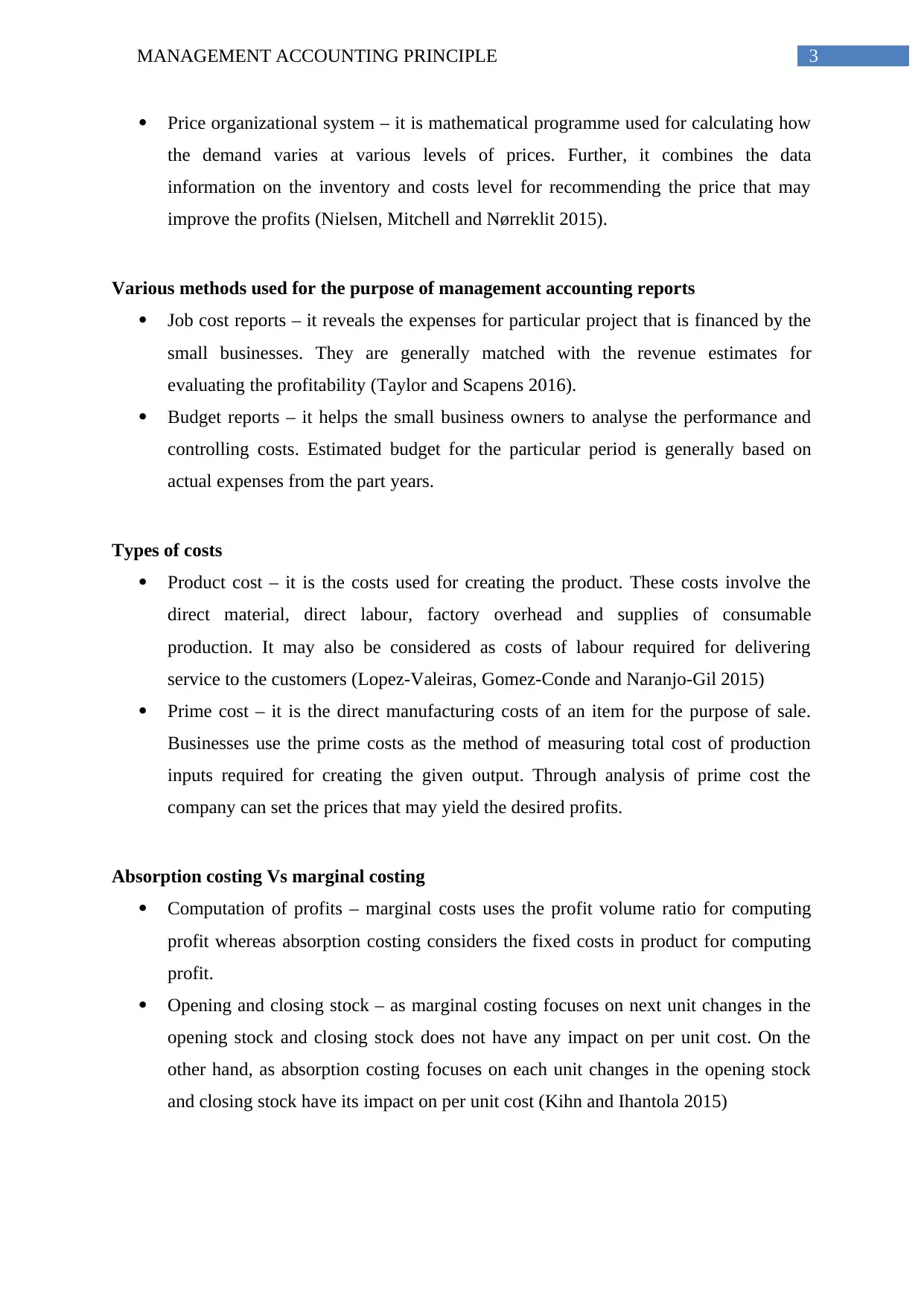
3MANAGEMENT ACCOUNTING PRINCIPLE
Price organizational system – it is mathematical programme used for calculating how
the demand varies at various levels of prices. Further, it combines the data
information on the inventory and costs level for recommending the price that may
improve the profits (Nielsen, Mitchell and Nørreklit 2015).
Various methods used for the purpose of management accounting reports
Job cost reports – it reveals the expenses for particular project that is financed by the
small businesses. They are generally matched with the revenue estimates for
evaluating the profitability (Taylor and Scapens 2016).
Budget reports – it helps the small business owners to analyse the performance and
controlling costs. Estimated budget for the particular period is generally based on
actual expenses from the part years.
Types of costs
Product cost – it is the costs used for creating the product. These costs involve the
direct material, direct labour, factory overhead and supplies of consumable
production. It may also be considered as costs of labour required for delivering
service to the customers (Lopez-Valeiras, Gomez-Conde and Naranjo-Gil 2015)
Prime cost – it is the direct manufacturing costs of an item for the purpose of sale.
Businesses use the prime costs as the method of measuring total cost of production
inputs required for creating the given output. Through analysis of prime cost the
company can set the prices that may yield the desired profits.
Absorption costing Vs marginal costing
Computation of profits – marginal costs uses the profit volume ratio for computing
profit whereas absorption costing considers the fixed costs in product for computing
profit.
Opening and closing stock – as marginal costing focuses on next unit changes in the
opening stock and closing stock does not have any impact on per unit cost. On the
other hand, as absorption costing focuses on each unit changes in the opening stock
and closing stock have its impact on per unit cost (Kihn and Ihantola 2015)
Price organizational system – it is mathematical programme used for calculating how
the demand varies at various levels of prices. Further, it combines the data
information on the inventory and costs level for recommending the price that may
improve the profits (Nielsen, Mitchell and Nørreklit 2015).
Various methods used for the purpose of management accounting reports
Job cost reports – it reveals the expenses for particular project that is financed by the
small businesses. They are generally matched with the revenue estimates for
evaluating the profitability (Taylor and Scapens 2016).
Budget reports – it helps the small business owners to analyse the performance and
controlling costs. Estimated budget for the particular period is generally based on
actual expenses from the part years.
Types of costs
Product cost – it is the costs used for creating the product. These costs involve the
direct material, direct labour, factory overhead and supplies of consumable
production. It may also be considered as costs of labour required for delivering
service to the customers (Lopez-Valeiras, Gomez-Conde and Naranjo-Gil 2015)
Prime cost – it is the direct manufacturing costs of an item for the purpose of sale.
Businesses use the prime costs as the method of measuring total cost of production
inputs required for creating the given output. Through analysis of prime cost the
company can set the prices that may yield the desired profits.
Absorption costing Vs marginal costing
Computation of profits – marginal costs uses the profit volume ratio for computing
profit whereas absorption costing considers the fixed costs in product for computing
profit.
Opening and closing stock – as marginal costing focuses on next unit changes in the
opening stock and closing stock does not have any impact on per unit cost. On the
other hand, as absorption costing focuses on each unit changes in the opening stock
and closing stock have its impact on per unit cost (Kihn and Ihantola 2015)
Secure Best Marks with AI Grader
Need help grading? Try our AI Grader for instant feedback on your assignments.
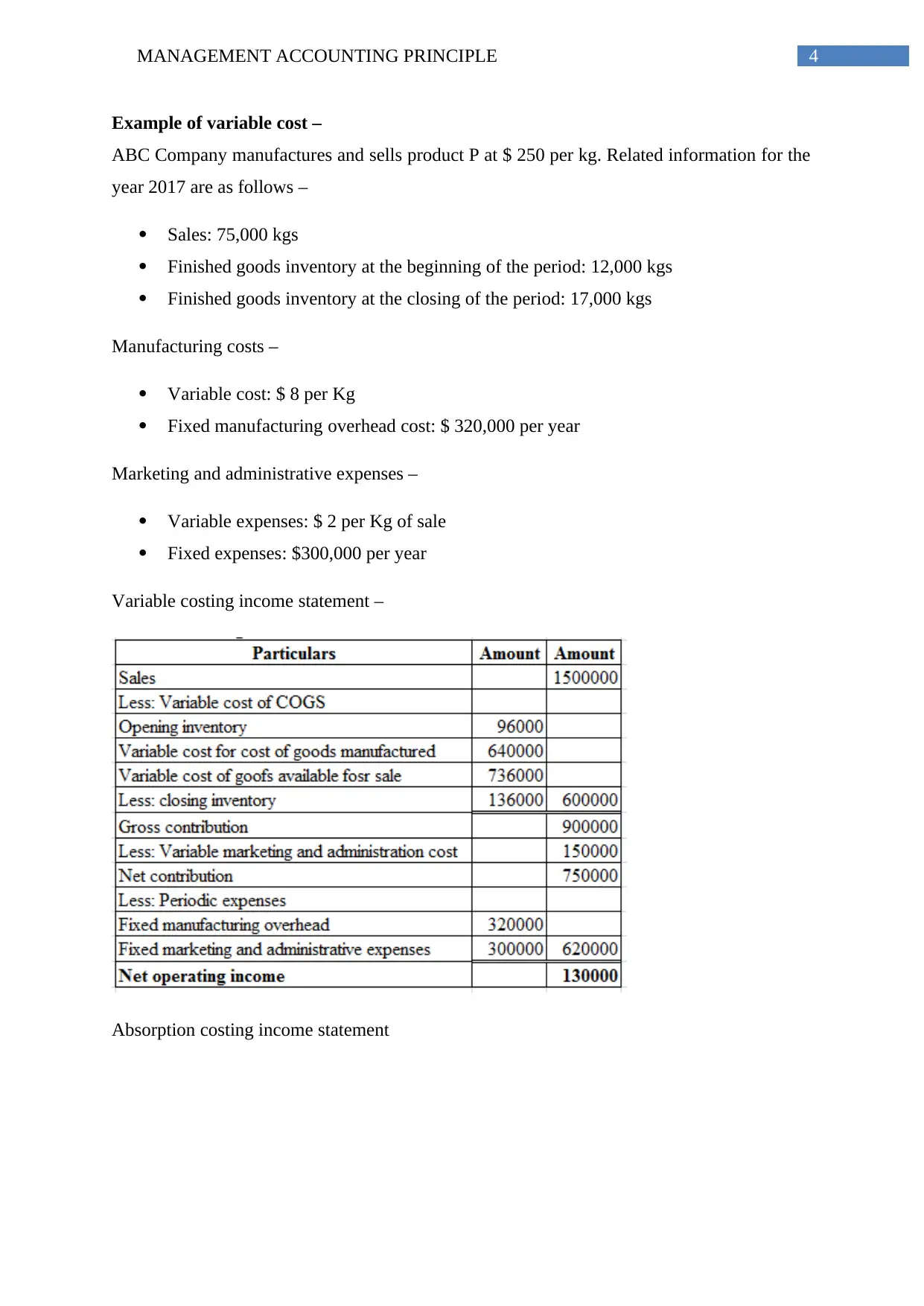
4MANAGEMENT ACCOUNTING PRINCIPLE
Example of variable cost –
ABC Company manufactures and sells product P at $ 250 per kg. Related information for the
year 2017 are as follows –
Sales: 75,000 kgs
Finished goods inventory at the beginning of the period: 12,000 kgs
Finished goods inventory at the closing of the period: 17,000 kgs
Manufacturing costs –
Variable cost: $ 8 per Kg
Fixed manufacturing overhead cost: $ 320,000 per year
Marketing and administrative expenses –
Variable expenses: $ 2 per Kg of sale
Fixed expenses: $300,000 per year
Variable costing income statement –
Absorption costing income statement
Example of variable cost –
ABC Company manufactures and sells product P at $ 250 per kg. Related information for the
year 2017 are as follows –
Sales: 75,000 kgs
Finished goods inventory at the beginning of the period: 12,000 kgs
Finished goods inventory at the closing of the period: 17,000 kgs
Manufacturing costs –
Variable cost: $ 8 per Kg
Fixed manufacturing overhead cost: $ 320,000 per year
Marketing and administrative expenses –
Variable expenses: $ 2 per Kg of sale
Fixed expenses: $300,000 per year
Variable costing income statement –
Absorption costing income statement
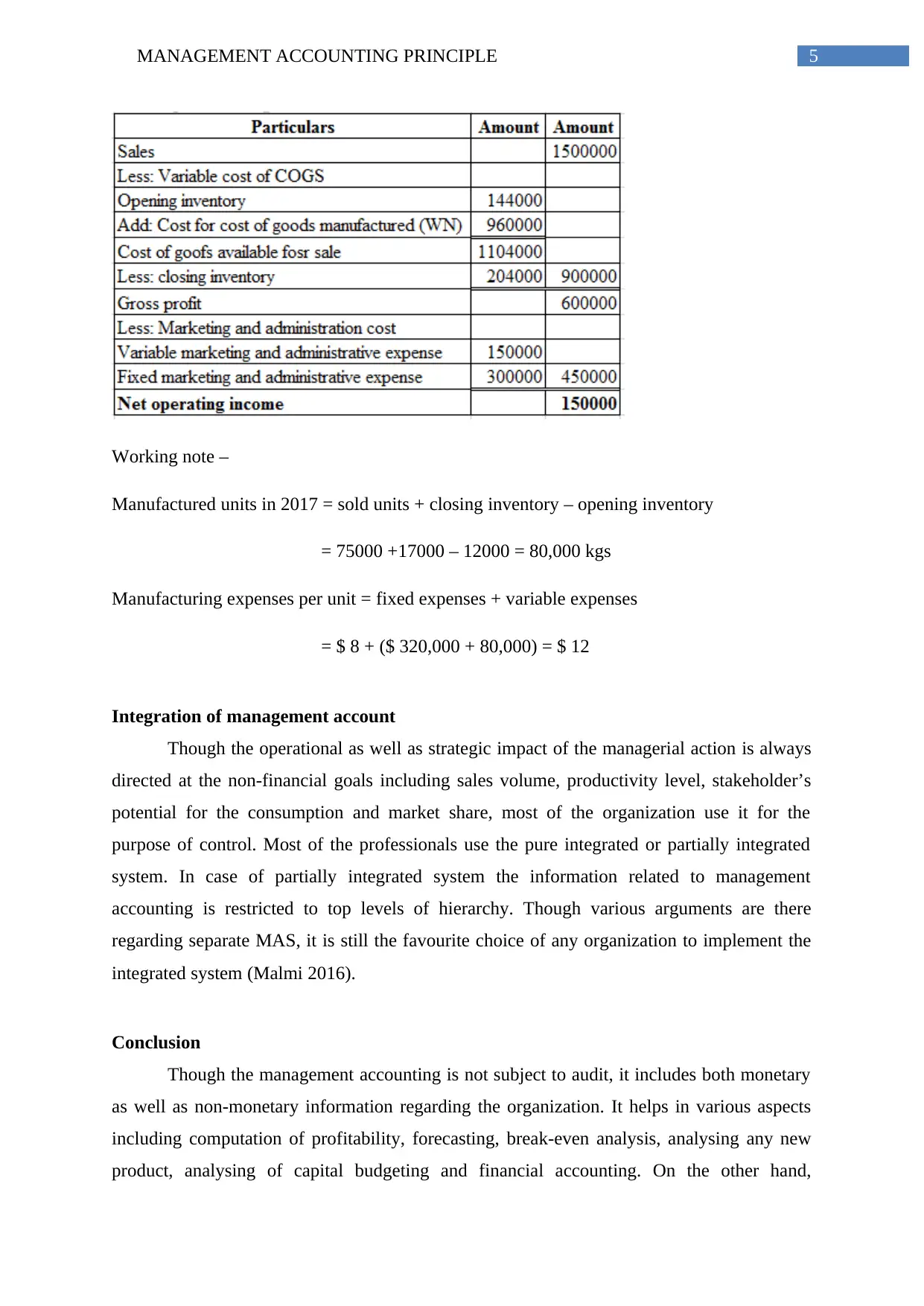
5MANAGEMENT ACCOUNTING PRINCIPLE
Working note –
Manufactured units in 2017 = sold units + closing inventory – opening inventory
= 75000 +17000 – 12000 = 80,000 kgs
Manufacturing expenses per unit = fixed expenses + variable expenses
= $ 8 + ($ 320,000 + 80,000) = $ 12
Integration of management account
Though the operational as well as strategic impact of the managerial action is always
directed at the non-financial goals including sales volume, productivity level, stakeholder’s
potential for the consumption and market share, most of the organization use it for the
purpose of control. Most of the professionals use the pure integrated or partially integrated
system. In case of partially integrated system the information related to management
accounting is restricted to top levels of hierarchy. Though various arguments are there
regarding separate MAS, it is still the favourite choice of any organization to implement the
integrated system (Malmi 2016).
Conclusion
Though the management accounting is not subject to audit, it includes both monetary
as well as non-monetary information regarding the organization. It helps in various aspects
including computation of profitability, forecasting, break-even analysis, analysing any new
product, analysing of capital budgeting and financial accounting. On the other hand,
Working note –
Manufactured units in 2017 = sold units + closing inventory – opening inventory
= 75000 +17000 – 12000 = 80,000 kgs
Manufacturing expenses per unit = fixed expenses + variable expenses
= $ 8 + ($ 320,000 + 80,000) = $ 12
Integration of management account
Though the operational as well as strategic impact of the managerial action is always
directed at the non-financial goals including sales volume, productivity level, stakeholder’s
potential for the consumption and market share, most of the organization use it for the
purpose of control. Most of the professionals use the pure integrated or partially integrated
system. In case of partially integrated system the information related to management
accounting is restricted to top levels of hierarchy. Though various arguments are there
regarding separate MAS, it is still the favourite choice of any organization to implement the
integrated system (Malmi 2016).
Conclusion
Though the management accounting is not subject to audit, it includes both monetary
as well as non-monetary information regarding the organization. It helps in various aspects
including computation of profitability, forecasting, break-even analysis, analysing any new
product, analysing of capital budgeting and financial accounting. On the other hand,
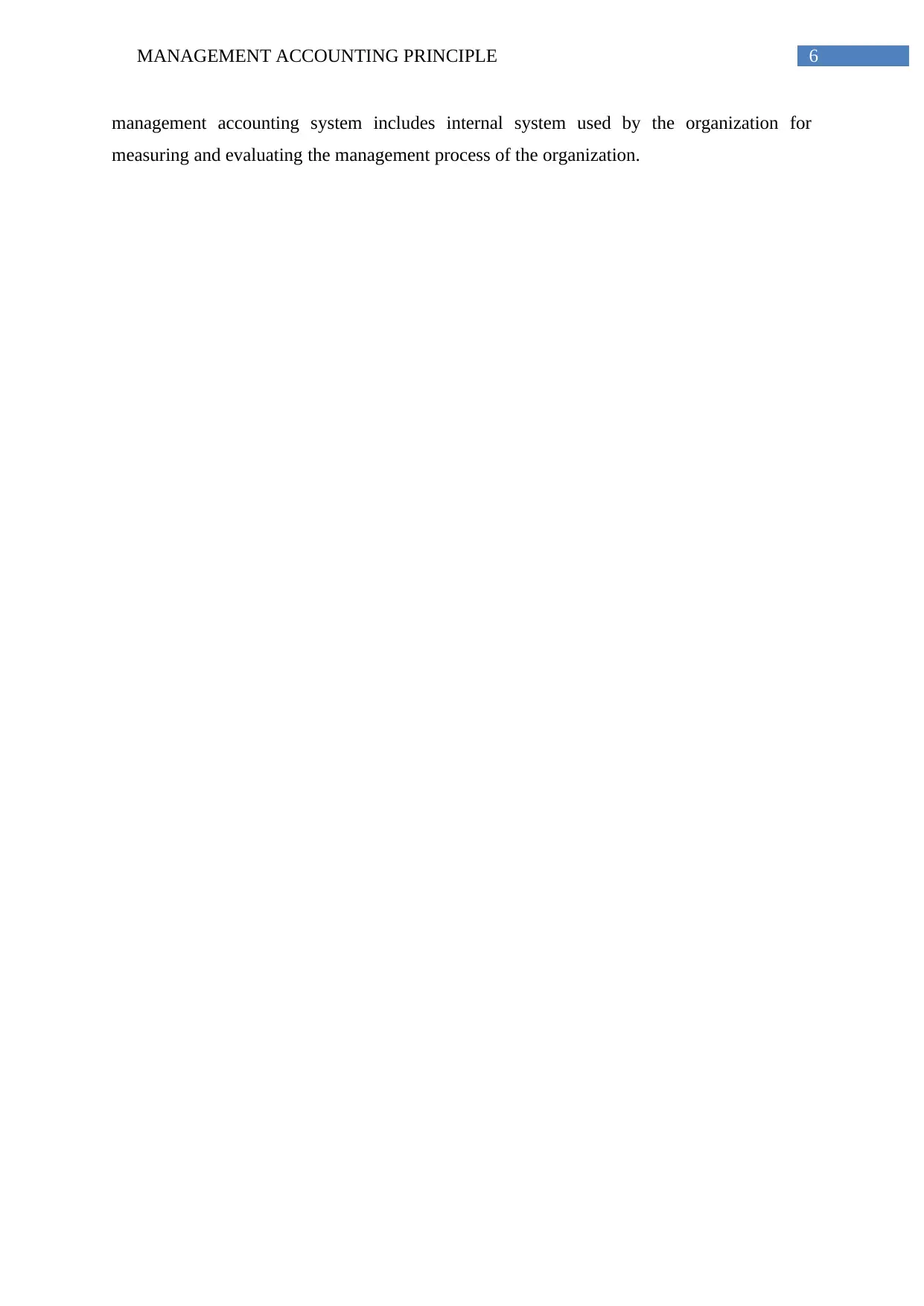
6MANAGEMENT ACCOUNTING PRINCIPLE
management accounting system includes internal system used by the organization for
measuring and evaluating the management process of the organization.
management accounting system includes internal system used by the organization for
measuring and evaluating the management process of the organization.
Paraphrase This Document
Need a fresh take? Get an instant paraphrase of this document with our AI Paraphraser
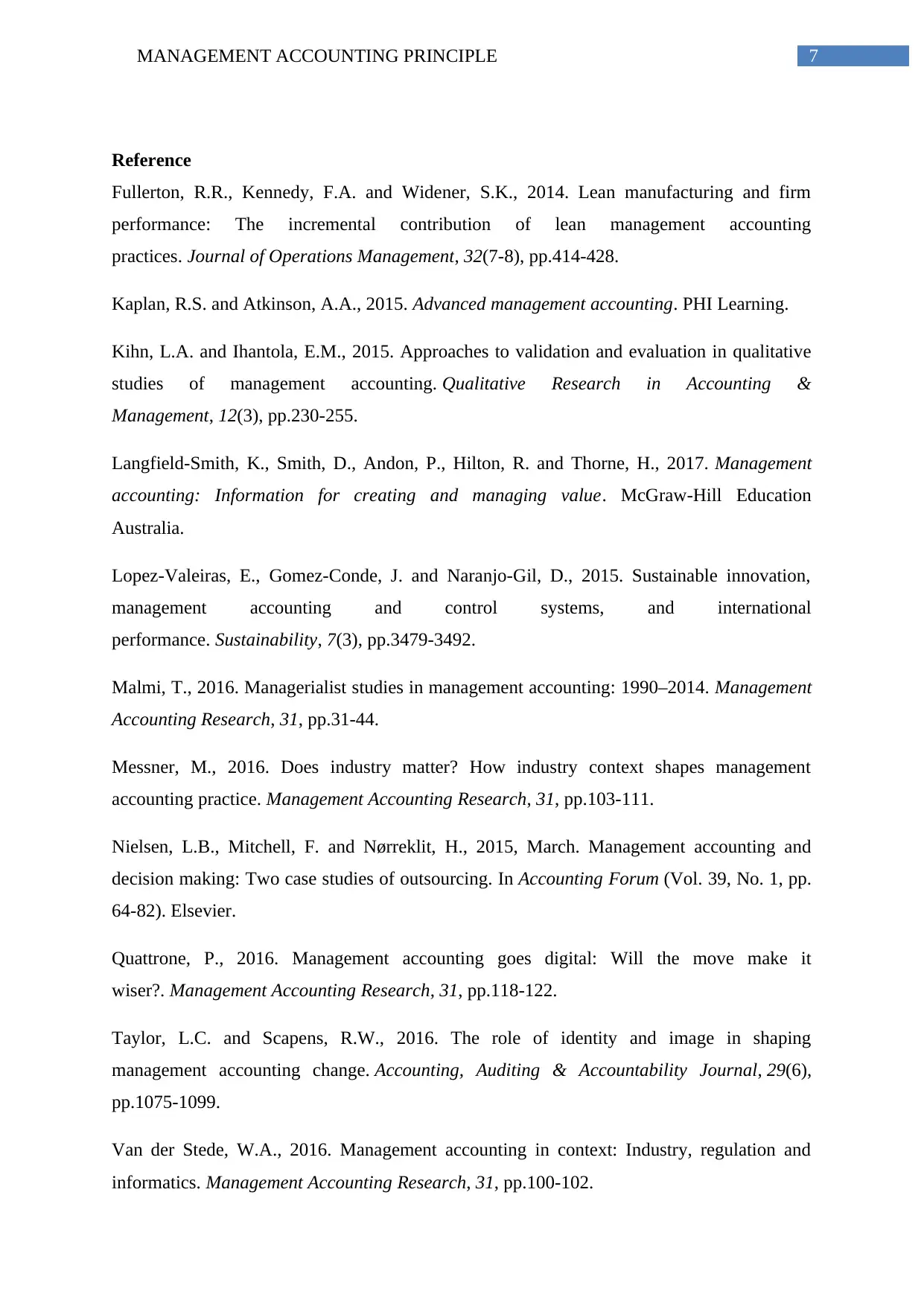
7MANAGEMENT ACCOUNTING PRINCIPLE
Reference
Fullerton, R.R., Kennedy, F.A. and Widener, S.K., 2014. Lean manufacturing and firm
performance: The incremental contribution of lean management accounting
practices. Journal of Operations Management, 32(7-8), pp.414-428.
Kaplan, R.S. and Atkinson, A.A., 2015. Advanced management accounting. PHI Learning.
Kihn, L.A. and Ihantola, E.M., 2015. Approaches to validation and evaluation in qualitative
studies of management accounting. Qualitative Research in Accounting &
Management, 12(3), pp.230-255.
Langfield-Smith, K., Smith, D., Andon, P., Hilton, R. and Thorne, H., 2017. Management
accounting: Information for creating and managing value. McGraw-Hill Education
Australia.
Lopez-Valeiras, E., Gomez-Conde, J. and Naranjo-Gil, D., 2015. Sustainable innovation,
management accounting and control systems, and international
performance. Sustainability, 7(3), pp.3479-3492.
Malmi, T., 2016. Managerialist studies in management accounting: 1990–2014. Management
Accounting Research, 31, pp.31-44.
Messner, M., 2016. Does industry matter? How industry context shapes management
accounting practice. Management Accounting Research, 31, pp.103-111.
Nielsen, L.B., Mitchell, F. and Nørreklit, H., 2015, March. Management accounting and
decision making: Two case studies of outsourcing. In Accounting Forum (Vol. 39, No. 1, pp.
64-82). Elsevier.
Quattrone, P., 2016. Management accounting goes digital: Will the move make it
wiser?. Management Accounting Research, 31, pp.118-122.
Taylor, L.C. and Scapens, R.W., 2016. The role of identity and image in shaping
management accounting change. Accounting, Auditing & Accountability Journal, 29(6),
pp.1075-1099.
Van der Stede, W.A., 2016. Management accounting in context: Industry, regulation and
informatics. Management Accounting Research, 31, pp.100-102.
Reference
Fullerton, R.R., Kennedy, F.A. and Widener, S.K., 2014. Lean manufacturing and firm
performance: The incremental contribution of lean management accounting
practices. Journal of Operations Management, 32(7-8), pp.414-428.
Kaplan, R.S. and Atkinson, A.A., 2015. Advanced management accounting. PHI Learning.
Kihn, L.A. and Ihantola, E.M., 2015. Approaches to validation and evaluation in qualitative
studies of management accounting. Qualitative Research in Accounting &
Management, 12(3), pp.230-255.
Langfield-Smith, K., Smith, D., Andon, P., Hilton, R. and Thorne, H., 2017. Management
accounting: Information for creating and managing value. McGraw-Hill Education
Australia.
Lopez-Valeiras, E., Gomez-Conde, J. and Naranjo-Gil, D., 2015. Sustainable innovation,
management accounting and control systems, and international
performance. Sustainability, 7(3), pp.3479-3492.
Malmi, T., 2016. Managerialist studies in management accounting: 1990–2014. Management
Accounting Research, 31, pp.31-44.
Messner, M., 2016. Does industry matter? How industry context shapes management
accounting practice. Management Accounting Research, 31, pp.103-111.
Nielsen, L.B., Mitchell, F. and Nørreklit, H., 2015, March. Management accounting and
decision making: Two case studies of outsourcing. In Accounting Forum (Vol. 39, No. 1, pp.
64-82). Elsevier.
Quattrone, P., 2016. Management accounting goes digital: Will the move make it
wiser?. Management Accounting Research, 31, pp.118-122.
Taylor, L.C. and Scapens, R.W., 2016. The role of identity and image in shaping
management accounting change. Accounting, Auditing & Accountability Journal, 29(6),
pp.1075-1099.
Van der Stede, W.A., 2016. Management accounting in context: Industry, regulation and
informatics. Management Accounting Research, 31, pp.100-102.
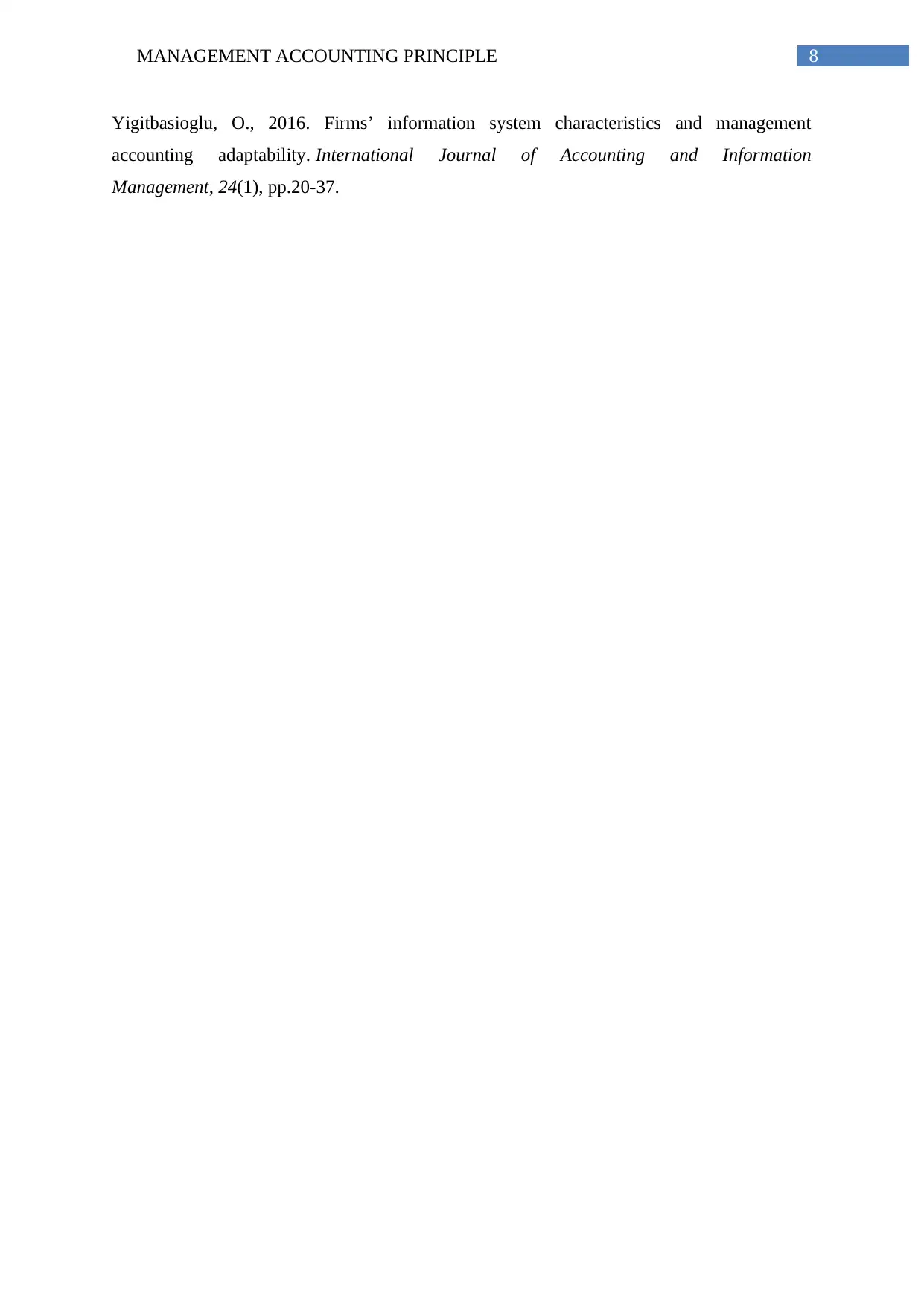
8MANAGEMENT ACCOUNTING PRINCIPLE
Yigitbasioglu, O., 2016. Firms’ information system characteristics and management
accounting adaptability. International Journal of Accounting and Information
Management, 24(1), pp.20-37.
Yigitbasioglu, O., 2016. Firms’ information system characteristics and management
accounting adaptability. International Journal of Accounting and Information
Management, 24(1), pp.20-37.
1 out of 9
Related Documents
Your All-in-One AI-Powered Toolkit for Academic Success.
+13062052269
info@desklib.com
Available 24*7 on WhatsApp / Email
![[object Object]](/_next/static/media/star-bottom.7253800d.svg)
Unlock your academic potential
© 2024 | Zucol Services PVT LTD | All rights reserved.





